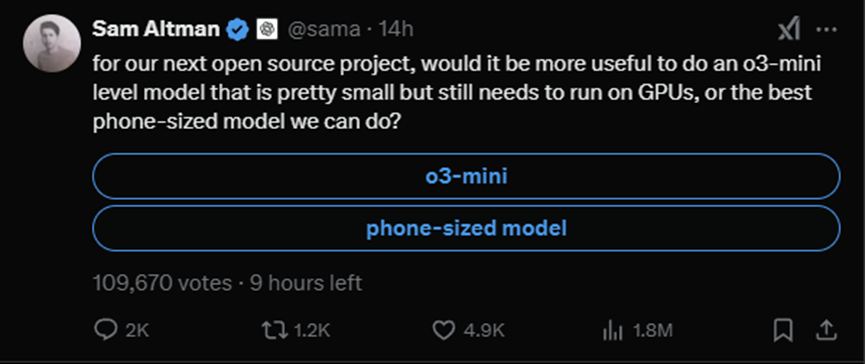Article source: AI Pioneer Officer
 Image source: Generated by AI
Image source: Generated by AI
Affected by the double attack of Deepseek and Grok3, OpenAI began to be in chaos.
On February 18, OpenAI CEO Sam Ultraman launched a vote on X and asked netizens: “For our next open source project, is it more useful to make an o3-mini level model that is quite small but still needs to run on a GPU, or the best mobile phone size model we can make?”

At present, more than 30,000 netizens have participated in the voting. The proportions of the two options are close, and the proportion of models with mobile phone size is 52%.
For the past six years, OpenAI has adhered to a closed-source strategy.
But this vote indicates that OpenAI will once again open source a big model.
In early February this year, Ultraman admitted in a rare way that OpenAI’s closed-source strategy was “on the wrong side.”
Ultraman said that DeepSeek’s lead will “not be as big as in previous years,” and said that OpenAI needs to develop different open source strategies on issues of open source weighting models and research results.
A few months ago, discussions about AI focused on closed-source models such as ChatGPT, Claude, and Gemini. OpenAI also built a strong city based on closed-source models through API+ subscription.
But with the emergence of DeepSeek, it not only proved that the open source model can also have capabilities comparable to GPT-4o level, but also has lower costs and can be deployed locally.
It can be said that DeepSeek almost reversed the direction of the market with one stroke, and the balance began to tilt towards the open source model.
Even Baidu, which has always advocated closed source, announced that it will open source the next generation Wenxin Model 4.5 series at the end of June.
Now, the entire AI ecosystem is embracing open source.
For example, on February 18 alone, multiple models were declared open source:
Kunlun Wanwei announced that it will open source SkyReels-V1, China’s first video generation model for AI short drama creation, and SkyReels-A1, an emotion-action controllable algorithm based on a video base model. Among them, SkyReels-V1 claims to be the strongest open source model for graphic video;
At the same time, Step Star and Geely Automobile have open-source a step Step-Video-T2V video generation model for cockpit scenes and a step Step-Audio voice interaction model;
On the other hand, Zhuji Power also announced that it will open source LimX VGM, a specific operation algorithm based on a large video generation model.
Just yesterday, when Musk released Grok3, the third-generation AI model of xAI, he announced that he would open source the code and weights of Grok-2.
Related reading: Musk released Grok3, mathematical science programming capabilities outperform DeepSeek-V3, Grok2 will be open source
Under such pinch and pressure, OpenAI’s rhythm is obviously disrupted.
On the 18th, Ultraman also posted a tweet about GPT-4.5, saying,”For highly demanding testers, the experience of experiencing AGI brought by trying GPT-4.5 is far more profound than I expected!”

This may imply that GPT-4.5 has entered the testing stage and is very close to official release.
Some netizens speculated that the purpose of Ultraman’s warming up GPT-4.5 was to deal with xAI’s Grok3.
A few days ago, Ultraman just announced the GPT series model update roadmap.
He said the o3 model will no longer be released as a stand-alone model, GPT-4.5 will be released in a few weeks, and GPT-5 will be released in a few months.



